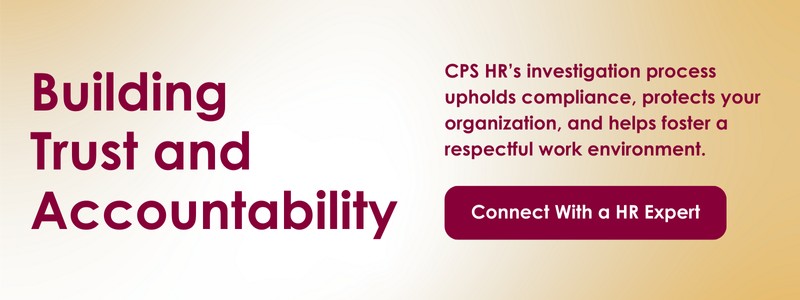Table of Contents
Maintaining a fair and compliant work environment is key for any organization.
Workplace investigations play an important role in addressing allegations of misconduct, enforcing company policies, and fostering a culture of accountability and trust. Not only do these investigations protect employees’ rights, they also safeguard the organization from legal and reputational risks. While the process can be complex, it is essential for maintaining transparency and resolving disputes fairly and lawfully.
A proper workplace investigation can mean the difference between a healthy company culture and one marked by mistrust. This is especially critical in cases involving harassment, discrimination, or other serious misconduct.
What is a Workplace Investigation?
A workplace investigation is a formal process used to examine concerns such as policy violations, misconduct, or other workplace issues. These investigations are typically triggered when an employee raises a complaint, or when potential violations of company policies or legal requirements are suspected. The goal is to gather facts, evaluate evidence, and determine whether the reported behavior violates company policy or legal regulations.
During this process, the investigator typically collects documentation, conducts interviews, and analyzes relevant evidence. In addition to resolving specific complaints, investigations help uphold a workplace culture grounded in fairness and respect.
Investigations are commonly initiated by cases of harassment, discrimination, retaliation, safety concerns, or abusive conduct. These issues can have significant impacts on morale, productivity, and the overall work environment.
Workplace Investigation Process
The often complex workplace investigation process requires careful planning, execution, and follow-up. The steps below outline how to approach the process efficiently and in accordance with legal and ethical standards.
1. Review the Complaint
After receiving a report of alleged misconduct, the investigator must carefully examine the details provided by the complainant. This involves assessing the nature of the allegation, evaluating any supporting evidence, and determining its potential scope of impact on the workplace.
At this stage, investigators should also determine whether the allegations are within the organization’s jurisdiction and policies. Some complaints may involve serious legal concerns, while others may relate to internal conduct or performance issues. If the complaint falls outside the organization’s scope or policies, a different approach may be most appropriate.
Key points to uncover during this review:
- What exactly is being alleged?
- Does the complaint provide sufficient detail for an investigation?
- Is there any supporting evidence?
2. Determine the Need for an Investigation
Not all complaints require a formal investigation. Minor issues may be resolved informally, but serious allegations involving misconduct, legal concerns, or harm to the organization and its employees will require a more structured approach.
The investigator needs to evaluate the severity and nature of the complaint, considering factors such as:
- Seriousness of the alleged misconduct
- Potential for harm or disruption to the workplace
- Credibility of the complainant and the evidence available
- Aany legal implications that require action
If an investigation is warranted, communicate the ensuing process and timeline to the complainant and provide them with available support resources. The investigation should ideally be conducted in a timely manner to avoid further damage to the employees and organization.
3. Make an Investigation Plan
Having a thoughtful plan for investigations ensures effectiveness and efficiency. When building a plan the investigator should:
- Outline ideal objectives and outcomes.
- Schedule interviews with those involved in the case (complainant, respondent, and any potential witnesses)
- Clearly communicate expectations for confidentiality and non-retaliation policies with interviewees.
- Determine what evidence (e.g., documents, emails, messages) will be reviewed.
- Follow legal and company guidelines.
In complex cases, consult legal or HR experts to ensure compliance with employment laws like harassment prevention or labor rights.
4. Notify the Respondent
The respectful participation of all parties is key to an effective investigation.
Once the investigation is underway, the respondent must be informed of the complaint and actions required on their part in the investigation process. Ensuring fairness and transparency gives the respondent an opportunity to understand the seriousness of the situation and present their side of the story.
Respondents should be informed of company policies, confidentiality expectations, their rights to a representative (if applicable), and when they can expect updates on the investigation outcome.
5. Gather Evidence
Evidence gathering is usually the most time-consuming but most crucial part of a workplace investigation. During this stage, the investigator will conduct the interviews with all involved parties. They will also collect relevant documentation, digital records, or other materials.
Interviews must be conducted in a fair and impartial manner, allowing each party to share their perspective without bias. Proper documentation of each interview and evidence collected is necessary to maintain the investigations integrity, and lead to a well-supported conclusion.
6. Analyze Evidence and Establish Findings
Once all evidence has been gathered, it’s time to analyze the findings.
This is a key stage in determining whether the allegations are substantiated and whether any workplace policies or laws have been violated. The investigator should cross-check statements from witnesses and interviewees, evaluate the quality of the evidence, and assess the credibility of the individuals involved. Policies and procedures should be carefully followed through this step to ensure compliance.
7. Report Findings and Next Steps
After thoroughly analyzing the findings, the investigator should compile a detailed report that outlines the results of the investigation for all involved. The report should clearly state whether the allegations were substantiated and explain any conclusions drawn from the investigation and its supporting evidence.
Most importantly, the report should include recommendations for the next steps. If the investigation confirms that misconduct occurred, the organization must decide what actions to take. Actions may include disciplinary measures, policy changes, mandatory employee trainings, and even company-wide training to avoid future cases.
Additional Best Practices
1. Follow Company Policies and Legal Guidelines
Ensure compliance with established company policies and legal standards through every stage of the investigation process. This alignment creates a fair environment for employees involved, safeguards the organization against legal repercussions, and maintains a culture of integrity.
2. Ensure Fairness
Treat all parties involved in the investigation with impartiality and respect. A fair process fosters trust in the system and encourages employees to report misconduct without fear of bias.
3. Keep It Confidential
Maintain strict confidentiality throughout the investigation to protect the privacy of those involved and preserve the integrity of the process. Unauthorized disclosure of information can undermine the investigation and lead to legal challenges.
4. Maintain Trust
Approach each investigation without preconceived notions. Objectively analyzing the facts ensures that conclusions are fair and accurate – based on evidence rather than personal biases.
Get Expert Assistance With Your Investigation Process
By conducting investigations that are thorough and respect legal and ethical standards, organizations protect all parties involved and uphold their commitment to accountability and transparency. This can place a lot of pressure on HR teams and leadership.
Lean on the expertise of CPS HR workplace investigation services to ensure fair, compliant, and effective resolutions in your organization.


